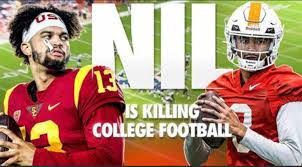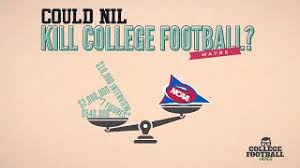
Recruiting has been ruined since NIL entered college football, and the game has worsened.
“NIL” or “name, image, and likeness” allows players to be paid in sponsorships and endorsements. However, college football programs themselves cannot directly pay these athletes. For instance, as of 2021, a business like Raising Canes may now offer an LSU recruit money to appear in commercials, but LSU cannot directly pay that athlete.

NIL killing college football July 27, 2021 College Football Nerds/ Youtube
The main reason NIL is hurting college football is because recruiting has now become nearly impossible. Top players are not going to a team for a commitment but for the money. This makes recruiting more of what playing for a school can offer them instead of what team develops a better player or puts him in the best position for success. “Recruiting as a whole has become an auction; there’s no commitment aside from the initial year,” argued Saint Paul’s sophomore Zachary Thomas.
Now that players are being paid money, the transfer portal has also gone out of control. The transfer portal allows players to switch schools freely. The term “committed” doesn’t mean as much anymore. In 2021 when NIL was introduced, over 3,000 players entered the transfer portal, compared to only two years before that in 2019, when 1,695 entered the transfer portal.
This is a problem because it messes up team chemistry and trust. If a team loses numerous players and recruits a lot of new players coming in every year, they don’t get to develop the connection they would have if they had stayed.
Uneven pay is another problem for players. Some players who are more hyped up end up making more money, which can lead to locker room problems. An anonymous student stated, “Uneven pay opens up opportunities for guys (who believe they deserve more money) to start fights and to pull other teammates away from each other. Essentially, the coaches and staff believe one player is worth more than the other, which can seriously hurt the psyche of these young players.”
The idea that some players in the locker room are playing for free and others are making millions makes it more of an individual sport than a team sport. Players chase the money instead of the chance to develop into good players who can succeed in the NFL.
Many college football fans believe that individual aspirations can negatively affect the team.
“Colorado is without a doubt a perfect example of NIL making college football about individual success instead of team success. Shedeur Sanders, Shilo Sanders, and Travis Hunter took the bulk of NIL money, therefore leaving little to no money to improve Colorado’s atrocious defensive and offensive lines,” said Saint Paul’s sophomore Zachary Thomas.
Another reason why the college football product is worse because of NIL is because the money is becoming so substantial that it can exceed NFL contracts. This is causing many great athletes to stay in college longer but try less when they are there. In other words, most players don’t rush to get into the NFL anymore. College football used to be the part of a player’s career that they developed and prepared for the big leagues. Players who are already getting paid NFL money have zero incentive to play in bowl games and less of a reason to give full effort. This hurts college football in a big way because one of the reasons fans preferred the college game over the NFL is that college players were playing passionately for their teams and winning, as opposed to money.
For instance, No. 1 quarterback recruit Bryce Underwood was originally committed to LSU, but he recently flipped his commitment, and many believe it’s because Underwood was offered more NIL money to play at Michigan. His total estimated NIL deal will add up to $12 million, including receiving some money from Barstool Sports president Dave Portnoy.
Some argue that NIL can be suitable for athletes because it gives them more opportunities because of the fair pay for their name and likeness, and it teaches how to manage money before they go pro. Many NFL rookies spend their money on frivolous things and create lousy spending habits once they get their contracts. In fact, it is widely reported that about 16% of NFL players file for bankruptcy after or during retirement.
However, the pros of helping the individual athletes are severely outweighed by the cons of ruining college football, and change is needed soon because at this rate, NIL will destroy the game.
“It will not resemble the sport we grew up with because players are making professional money in college,” said Saint Paul’s sophomore Jake Bergeron.
What is the solution?
A good solution for this would be implementing a cap and contract system. Similar to the NBA, each college should be able to offer a player a set maximum amount. Furthermore, they should make a contract that makes players stay and not be able to enter the transfer portal every year. For example, if the player cap salary is $1 million per year, a player can be signed to a 2-4 year contract with a maximum of $1 million per year.
Additionally, teams can only sign a certain number of players to that maximum deal. This will keep the top players getting the most money and prevent all players from getting the maximum amount.
These two rules would calm down the transfer portal, making it a place where players who are not getting paid or have finished their contracts can enter.
This addition will keep players working hard to reach that maximum contract, keeping the game competitive, representing a nice balance between players’ individual benefits and flexibility while preserving the nature of college football.
Featured Image Photo Credit: TempleFootballForever.com
Published By: benjaminsikes2027
Back to Wolf Pack Press